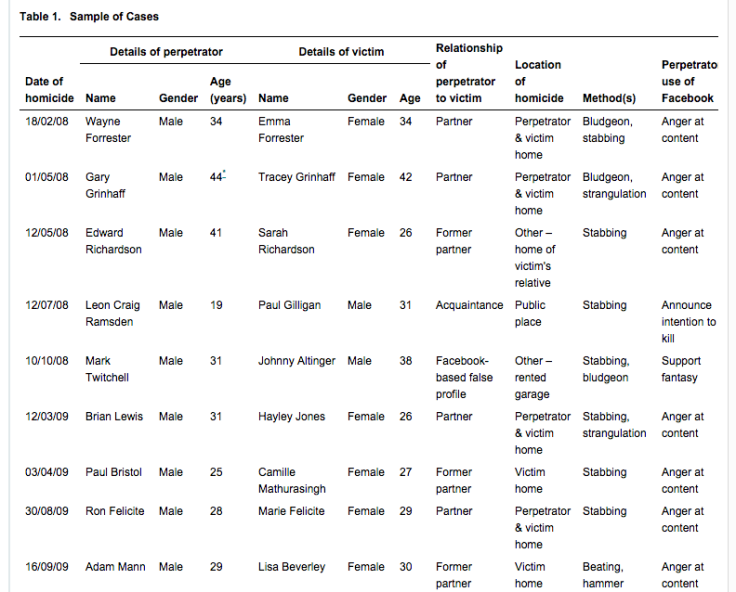Murder By Facebook: 6 Types Of Assassins Who Stalk The World's Largest Social Network

Academic research on the intersection of Facebook and murder has identified different types of "Facebook murderers." Using a sample of 48 cases between 2008 and 2013 in which Facebook interactions played a role, criminologists at Birmingham City University have published a paper outlining six different types of Facebook-related motivations that would incite someone to kill.
So how might Facebook figure into murder? Let us count the ways.
1. The Reactor
The most common example that the paper came up is what the researchers termed "a reactor." This is a murderer who lashes out in response to news seen on the site that someone shares of his or her own volition. For example, a London man in 2008 killed his wife after reading her Facebook posts stating that she had separated from him and wanted to meet other men. Reactors account for 27.1 percent of the cases studied.
2. The Informer
The next most common is "the informer," in which someone uses Facebook as a platform to announce their murderous intentions. It's a means to exert control over another and instill fear. A Colorado man in 2013 nabbed his two-year-old daughter from his ex-partner and followed up with a post on Facebook that read, "I told u I can't live without u lol u thought I was joking now me n Mia out this bitch." He later shot his daughter and then himself. Informers are 22.9 percent of cases studied.
3. The Antagonist
"The antagonist" is one who takes a negative online interaction into the offline world. Consider two people duking it out verbally on Facebook only to later learn that one has killed the other. This is exactly what happened between two young men in London in 2009. This approach accounts for 16.7 percent of the Facebook murders.
4. The Fantasist
"The fantasist" is one of the more curious examples given. It describes one who uses murder to perpetuate a fantasy as his or her line between what is real and what is not becomes increasingly blurred. A Canadian man, for example, rented a garage and set it up as a "kill room," directly inspired by television's Dexter. He created a Facebook account that masqueraded as the TV character and described his preparations for a murder before killing a man in the rented space. Fantasists are 12.5 percent of the whole.
5. The Predator
"The predator" is one who creates a false profile to gain the trust of a victim before luring them to a place where they are vulnerable. After learning of a young woman's interest in animals, an Australian man lured her out to a remote nature preserve by way of a fake Facebook account. The appearance was that he would be leading a training camp for wildlife enthusiasts, but he used the opportunity to murder her. Predators comprise 12.5 percent of Facebook murder cases.
6. The Impostor
"The impostor" is a Facebook killer who reappropriates a genuine Facebook profile as his or her own in order to mislead others, giving the impression that a victim is still alive. For example, a U.K. man in 2010 killed his partner and used her Facebook profile to tell the false story that she had taken off for the Canary Islands. Impostors are 8.3 percent of cases studied.
To be clear, this is not to say that Facebook is somehow culpable in these deaths. "Facebook is no more to blame for these homicides than a knife is to blame for a stabbing," Elizabeth Yardley told NBC News. "It’s the intentions of the people using these tools that we need to focus upon.”
And being on Facebook doesn't make you more likely to be murdered. "We argue that the cases in our sample are largely typical of homicide in general," the paper's authors said. Facebook was involved, but it could've just as easily been email, text messaging or face-to-face conversation.
Facebook did not immediately reply to request for comment on this story. Below are some of the case summaries.

© Copyright IBTimes 2025. All rights reserved.




















